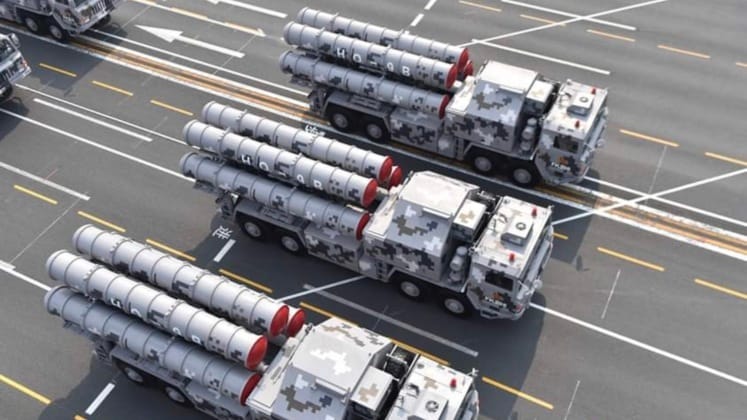- The Afterburn Podcast
- Posts
- Nuke Testing | Anduril CCA Takes Flight | 🎯 China's HQ-9
Nuke Testing | Anduril CCA Takes Flight | 🎯 China's HQ-9
Lowdown Newsletter

Forwarded this email? Sign up here
Edited by: Sidney McAlear
FLIGHT LINE
🎯 Trump Orders Pentagon to Begin Immediate U.S. Nuclear Weapons Testing
Donald Trump has directed the Department of Defense to resume U.S. nuclear‑weapons testing “on an equal basis” with adversaries, following a 33‑year moratorium. The announcement came via social media just ahead of a summit with Xi Jinping. (more)

Lowdown Debrief:
To say this marks a major policy shift might be an understatement. The U.S. last tested a nuclear weapon in 1992. China conducted its last test in 1996, and Russia conducted its last test in 1990. North Korea is the only nation to have recently conducted a nuclear test in 2017. China, Russia, and the U.S. are all signatories to the 1996 Comprehensive Nuclear Test Ban Treaty. However, China and the U.S. never ratified the treaty, and Russia ultimately withdrew its ratification in 2023.
Which Chinese long-range SAM system is often compared to Russia’s S-400 for its extended-range capabilities and advanced radar suite? |
Did you catch our latest episode with Dave “Chip” Berke - Only Marine to fly the F-22 and commander of the Marines ’ first F-35 squadron? Find our episodes here.
Watch & Listen
Stories from the cockpit, jets, current events, and missions.
🎯 Anduril’s Drone Wingman Kicks Off Flight Tests for USAF CCA Program
Anduril Industries’s jet‑powered YFQ‑44A prototype has completed its first flight test as part of the Collaborative Combat Aircraft (CCA) program, advancing the United States Air Force’s goal of pairing autonomous drones with crewed fighters. The test, conducted at an undisclosed California site, follows the earlier flight of General Atomics YFQ‑42A prototype and marks a significant step toward fielding a potential fleet of 1,000 “loyal wingman” aircraft. (more)
Lowdown Debrief:
The CCA program, launched in April 2024, aims to field a fleet of collaborative uncrewed aircraft capable of strike, ISR, and EW missions alongside fifth-and sixth-gen fighters like the F‑35 and NGAD. In a break from traditional procurement, the Air Force selected only two finalists: Anduril and General Atomics, explicitly excluding legacy primes such as Lockheed Martin, Boeing, and Northrop Grumman from Phase 2. This marks a deliberate shift toward rapid-cycle, software‑defined development, with Anduril’s YFQ‑44A reaching flight in just 556 days from contract start. A production award is expected in FY 2026 for an initial fleet of 1,000 autonomous wingmen.
YFQ-44A took flight today. Anduril has launched a new age of airpower with the push of a button.
From clean-sheet design to one-click takeoff in 556 days.
— Anduril Industries (@anduriltech)
11:33 PM • Oct 31, 2025
🎯 USAF Seeks 1,558 Fighters to Sustain Low‑Risk Global Operations
The U.S. Air Force told Congress it needs a fleet of 1,558 combat‑coded fighters, roughly 300 more than it currently has, to maintain a low‑risk posture for global operations through 2035. Achieving that goal will require accelerated procurement of F‑35As and F‑15EXs, as well as legislative support for platform retirements and budget increases. (more)
Lowdown Debrief:
The requirement is outlined in the Air Force’s newly released Long-Term Fighter Force Structure report, which defines 1,558 fighters as the threshold for low-risk global conflict readiness, 1,367 for medium risk, and anything less as high risk. The current fleet includes about 1,271 combat‑coded fighters, well short of the target. Meeting the gap would rely on growing the F‑35A fleet, expanding F‑15EX procurement, and retiring older aircraft like the A‑10 and legacy Block 30/40 F‑16s. The report also references the future addition of at least 1,000 autonomous Collaborative Combat Aircraft as a complementary force multiplier, though timelines remain fluid.
Like this content? Help us grow by spreading the word
For Instagram, take a screenshot and share it on your story!
SNAPSHOT
🚩 Gen. Kenneth Wilsbach confirmed as U.S. Air Force Chief of Staff. Wilsbach, who had previously retired this summer as the Air Combat Commander, was recently nominated to replace the early departure of General Allvin. (more)
🚩 Heavy Russian Il‑76 cargo plane lands in Caracas amid U.S.–Venezuela tensions. (more)
🚩 Former U.S. Army sergeant sentenced to four years in prison for spying for China. (more)
🚩 The U.S. Air Force has awarded a prototyping contract for a successor to the GBU-57 Massive Ordnance Penetrator (MOP) with the Next Generation Penetrator (NGP). The 30,000-lb bunker-buster is used to strike Iran’s fortified nuclear sites, indicating a push to develop next-generation deep-penetration munitions. (more)
🚩 Colorado launches lawsuit to block the relocation of US Space Command HQ from Colorado Springs to Huntsville, Alabama, citing alleged political retaliation tied to state mail‑in voting policies. (more)
🚩 SpaceX and EchoStar struck a deal for 50 MHz of U.S. S-band and global MSS spectrum to power Starlink’s next-gen Direct-to-Cell network with 5G coverage and up to 100× more capacity. (more)
Support The Afterburn Podcast on Patreon
Unlock exclusive 'There I was...' stories & and ad-free interviews!
THREAT OF THE DAY (TOD)

HQ-9
HQ-9 Surface-to-Air Missile System
Country of Origin: China
Initial Operational Capability (IOC): ~2003 (HQ-9A); upgraded variants fielded mid-2010s
Type: Long-range, high-altitude surface-to-air missile (SAM)
Manufacturer: China Precision Machinery Import-Export Corporation (CPMIEC)
Engagement Range:
• HQ-9A: ~108 nautical miles (200 km)
• HQ-9B: ~162 nautical miles (300 km)
Engagement Altitude: ~1,600 ft to 98,000 ft (0.15 to 30 km)
Guidance: Inertial midcourse with data link updates and terminal active/semi-active radar homing
Radar System: HT-233 phased-array fire-control radar with multifunction tracking and guidance role; based on Russian 30N6E designs
Targeting Capability: Fixed- and rotary-wing aircraft, cruise missiles, UAVs, & ballistic missiles
Variants:
HQ-9A: Improved anti-jam and range extension
HQ-9B: Enhanced radar, seeker upgrades, range up to ~162 nm
HQ-9C: Under development, reportedly using AESA radar and fully active guidance
FD-2000: Export model, offered with modular radar options
FD-2000B: Export version with extended range (~135 nm)
Proliferation:
Exported to: Pakistan, Algeria, Turkmenistan (FD-2000 series)
Bidders/Interest from: Turkey (lost to SAMP/T), Egypt, Belarus, Middle East
PLA Deployment: Extensively deployed by the PLA Air Force and Rocket Force, including in coastal batteries near Taiwan, and installations in the South China Sea

Chinese HQ-9
Answer: It was the HQ-9B…think skinny my friends.

Reply